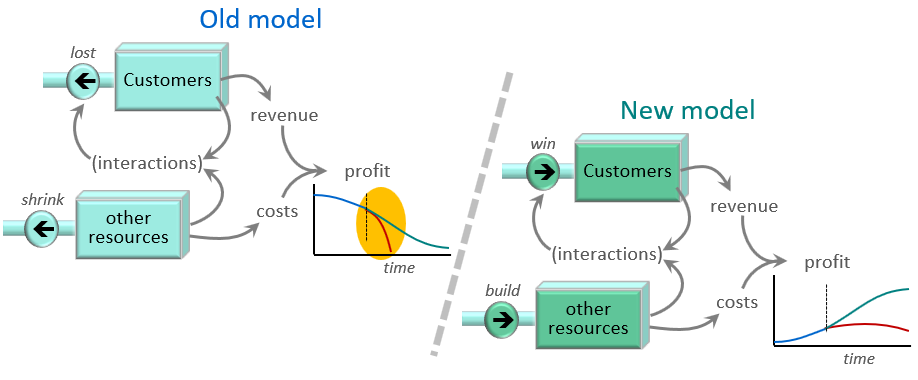I just explained how to define and scale opportunities that may exist to extend our strategy, and how to test a promising opportunity with a digital-twin business model. Basically, that’s about adding something more to what already works.
I have also stressed that successful firms do not keep changing what they do in any fundamental way.
When the old business model will die
BUT… sometimes an existing business model will die. Whether driven by changing technology or some other innovation, customers will drift away. They may move to some new product that fulfils their needs (e.g. from cameras to phones) or to some new means of getting the same product (e.g. from video-rental to streaming).
Do nothing, or fail to change, and the firm dies (e.g. Kodak in photo-film … and you may be old enough to recall that the global video-rental stores giant Blockbuster turned down the opportunity to acquire the fledgling Netflix, when video streaming barely worked at all!).
So to avoid that fate, we must do two things:
- We must figure out how the new business model will work. To do that, we can simply apply the core principles of a strategic architecture to lay out the new system structure and test it with a digital-twin business model (… how many potential customers, winnable at what rate, delivering what sales and revenue, requiring what product/service-range, capacity, staffing, at what cost, delivering what growing profits).
- But also – and much more tricky – we have to plan and manage the transition over what may be many years.
What could possibly go wrong?
Even if the new business model is 100% robust, getting from A to B is fraught with dangers:
- Existing customers for the old business model may slip through our fingers, deserting us for rivals who get to a more compelling product/service offer faster than we can do so.
- We may fail to build the new kinds of staff, probably in several functions, that the new business model needs – in operations, sales, customer-support …
- Meanwhile existing staff may see the writing on the wall and desert the ship they fear will sink fast.
- We may not be able to master the new technology, or build effective and efficient new-type capacity.
Retire the old model – don’t kill it.
… and while our attention is laser-focused on how to design and build the new business model, there’s a real danger of neglecting the old model. Why does that matter?
- Customers of the old business will likely switch at different rates. Early adopters may jump first, but the old business may collapse if we neglect the laggards who want to stick with the old model for a while.
- Our existing staff may not have the skill-set the new business needs, but [a] they are vital to achieving a managed contraction of the old business and [b] many may be trainable for the brave new world (where, of course, new-skill staff will be very scarce and costly!)
- … and we need the cash flow from the declining old business to fund the costly build up of the new.
This means we have to manage both of these strategies in parallel, and we must not let the old model just collapse.

Next time, we will look at a case that illustrates how these parallel strategies can – and must – be planned and managed together … and how a digital-twin business model of the change can help.
The post Planning and managing full strategic change [A] appeared first on Kim Warren on Strategy.